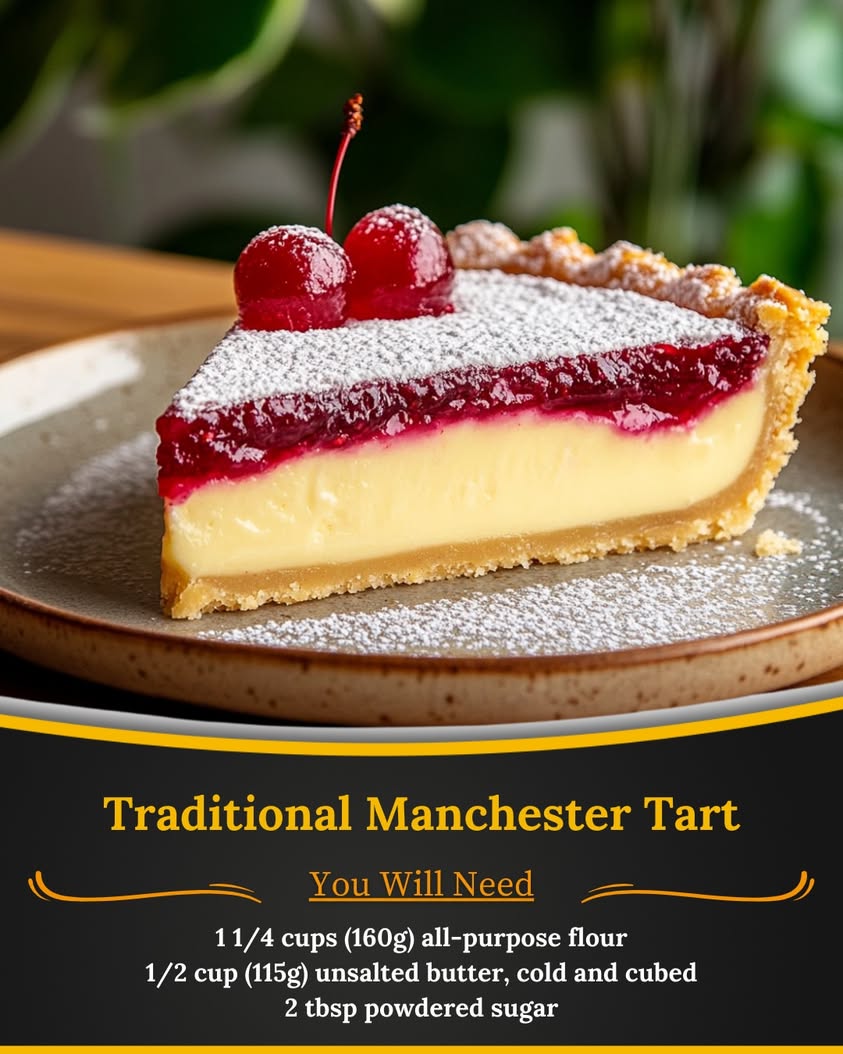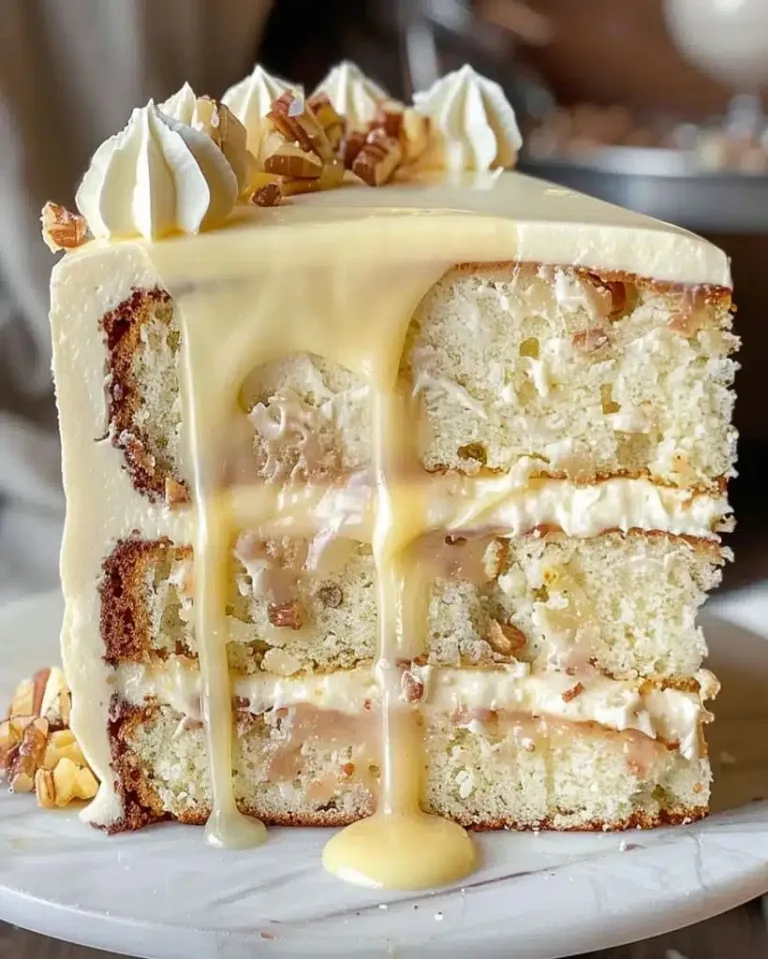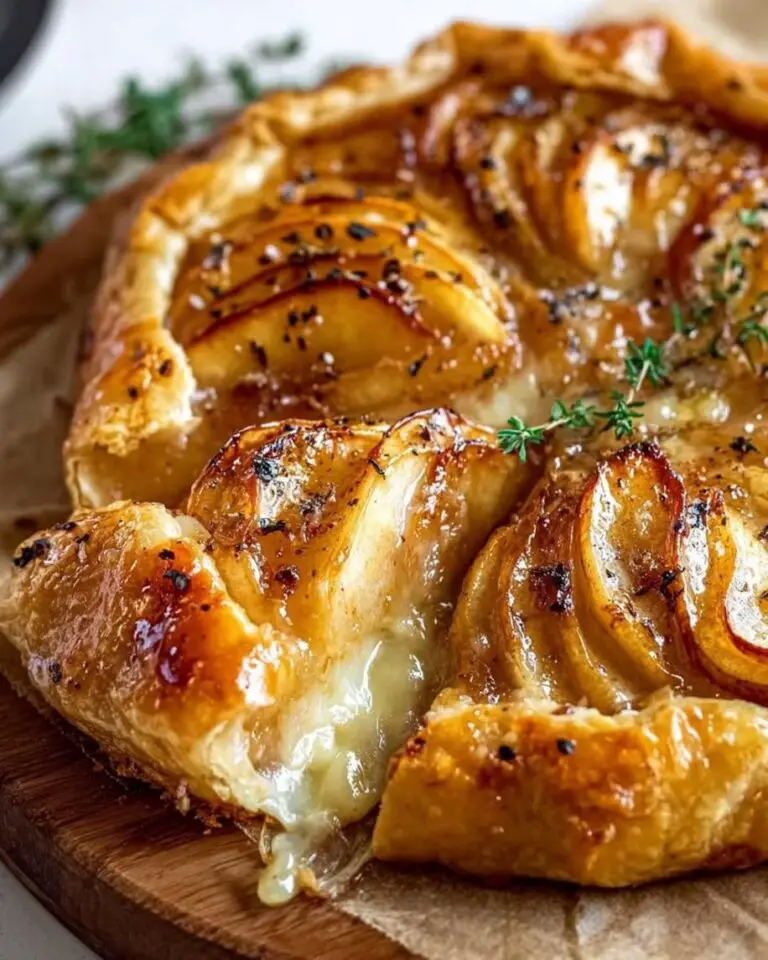Deliciously Classic Manchester Tart Recipe: A Culinary Treasure

Traditional Manchester Tart: A Taste of Classic British Dessert
Traditional Manchester Tart is a delightful dessert that brings the flavors of England to your table. With its buttery pastry, rich custard filling, and a touch of fruity jam, this traditional recipe is a celebration of simple yet classic ingredients. Each bite offers a harmonious blend of sweetness and tartness that dances on your taste buds, making it perfect for both special occasions and casual gatherings.
The history of the Manchester Tart runs deep, rooted in the culinary traditions of Northern England. This dessert embodies the spirit of home-cooked comfort, evoking memories of family gatherings and celebrations. The unique combination of smooth custard, tart raspberry jam, and sweet coconut topping is sure to bring joy to anyone who tries it. It is not just a dessert; it’s a piece of history served on a plate.
Quick Recipe Highlights
- Flavor Profile: The tart features a delightful combination of creamy custard balanced with the tangy sweetness of raspberry jam, complemented by the nutty flavor of coconut.
- Texture: The smooth and creamy custard filling is perfectly contrasted by the crunchy coconut layer and crisp pastry base, creating a satisfying mouthfeel.
- Aroma: The warm scent of baked custard mingles with the fruity aroma of raspberry, inviting you to indulge in a slice.
- Visual Appeal: This dessert presents beautifully with its golden pastry, vibrant raspberry layer, and snowy white coconut topping, making it a feast for the eyes.
- Skill Level Needed: With some basic pastry skills and attention to detail, this dessert can be tackled by novice bakers looking to impress.
- Special Equipment: A pie dish and a whisk are essential, along with basic kitchen tools that ensure your pastry and custard turn out perfectly.
Recipe Overview
- Difficulty Level: The Traditional Manchester Tart is classified as medium difficulty. While the steps are straightforward, working with pastry and custard requires a bit of precision to achieve the best results.
- Category: This dessert falls under the categories of Sweet Treats and Afternoon Tea, making it ideal for dessert lovers and tea enthusiasts alike.
- Cuisine: Originating from England, the Manchester Tart is a nostalgic example of British baking, embodying the heart of traditional cuisine with a modern twist.
- Cost: This recipe is relatively cost-effective, utilizing common pantry ingredients like flour, sugar, butter, eggs, and coconut, making it accessible for all budgets.
- Season: Although the tart can be enjoyed all year round, spring and summer are particularly fitting due to the refreshing flavors that resonate with warmer weather.
- Occasion: Perfect for birthdays, tea parties, or family gatherings, the Manchester Tart is a crowd-pleaser that makes any event feel special.
Why You’ll Love This Recipe
The Traditional Manchester Tart is truly a delight for your senses. The combination of rich, velvety custard with the refreshing tang of raspberry jam creates a flavor adventure that satisfies sweet cravings without being overwhelmingly sugary. The contrasting textures — a crispy pastry base, smooth filling, and chewy coconut topping — create an exciting experience in every bite.
Preparation is a breeze, making it a great option for both beginners and experienced bakers. The custard can be made in advance, allowing you to simply assemble and bake when you’re ready to impress guests. This convenience does not sacrifice taste, ensuring that your dessert will be memorable with minimal fuss.
From a nutritional perspective, the ingredients used in this dessert provide essential nutrients. Eggs add protein and vitamins, while coconut offers healthy fats and fiber. The raspberry jam contributes antioxidants and a burst of flavor.
Traditionally served at gatherings, the Manchester Tart has a unique charm that encourages sharing and conversation. Whether offered at a tea party or served as a comforting family dessert, this tart invites everyone to savor its rich heritage together.
Moreover, this recipe is economical. It utilizes basic ingredients that are often already in your pantry. The cost-effectiveness means you can make a batch without straining your budget, allowing for more frequent indulgence.
Historical Background and Cultural Significance
The Traditional Manchester Tart has its roots deep in British culinary history, dating back to the Victorian era. This dessert, named after the bustling city of Manchester, was originally created as a tribute to the region’s love of sweets. Its accessibility and use of locally sourced ingredients made it a favorite among families, ensuring its place in English kitchens.
Culturally, the Manchester Tart represents not just a delicious dish but a connection to heritage and memories. It is often served during community gatherings, evoking nostalgia among those who grew up enjoying it. This dessert is a symbol of comfort, reminding many of family recipes passed down through generations.
Over the years, variations of the Manchester Tart have emerged, including different fruit fillings and toppings to cater to dietary preferences and seasonal availability. Despite these adaptations, the essence of the original recipe remains cherished, preserving its significance within British cuisine.
The regional variations often highlight local ingredients, showcasing the adaptability of this tart across the UK. Whether with fresh apples from the orchards of Kent or berries from the Scottish Highlands, each rendition tells the story of its locale, bringing further richness to its heritage.
Ingredient Deep Dive
- Pâte Brisée (Pastry): This classic French pastry brings a buttery richness that lays the perfect foundation for the tart. Traditionally made from flour, butter, and a touch of salt, it has become a staple in many baking recipes.
- The nutritional benefits of a good pastry include providing carbohydrates for energy, while the butter contributes healthy fats. When selecting flour, look for high-quality options that ensure a flaky texture.
- Storage is straightforward; keep any leftover pastry tightly wrapped in the fridge for up to three days, or freeze for longer preservation.
- Substitutions can include using whole wheat flour for added fiber or gluten-free alternatives for those with dietary restrictions.
- Custard Filling: The custard is made from a combination of eggs, milk, sugar, and vanilla, creating a rich and creamy filling that is integral to the tart. Eggs are a good source of protein and essential nutrients.
- Choose fresh, free-range eggs for superior flavor and nutritional value, while whole milk enhances the creaminess of the custard. Store any leftover custard in the refrigerator and use within a couple of days.
- If dietary restrictions exist, custard can be made with dairy alternatives like almond or coconut milk, although a slight adjustment in texture may occur.
- Raspberry Jam: Sweet and tangy raspberry jam provides a burst of flavor that complements the custard. Raspberries are packed with antioxidants and vitamins.
- When selecting jam, opt for natural versions with minimal added sugar for a healthier option. Homemade raspberry jam can elevate the dessert further if time allows.
- Store jam in a cool, dark place and keep it sealed tightly to maximize its shelf life — typically, it lasts for up to a year.
- Substitutions might include other fruits, such as strawberry or apricot, for those looking to change up the flavor profile.
Common Mistakes to Avoid
- Failing to blind bake the pastry can result in a soggy base. Make sure to dock the pastry with a fork and use pie weights during baking.
- Overcooking the custard leads to a rubbery texture instead of a smooth filling; remove from heat as soon as it thickens.
- Not allowing the tart to cool before slicing can lead to a messy presentation. Patience is key for clean slices.
- Ignoring ingredient temperatures—cold butter and eggs can affect the pastry and custard, so bring them to room temperature beforehand.
- Skipping the use of quality ingredients can compromise the flavor; always use the best butter, eggs, and vanilla you can find.
- Using too much jam can overpower the custard flavor; a moderate layer is ideal for balance.
- Failing to check for doneness; utilize visual cues such as the custard being set but still jiggling slightly in the center.
- Not preheating the oven can lead to uneven baking. Always ensure that your oven is at the correct temperature before starting.
Essential Techniques
Blind Baking: This technique prevents the pastry from becoming soggy by pre-baking it before adding the filling. To master blind baking, use pie weights or dry beans to ensure the crust retains its shape. Look for a light golden color as a visual cue for doneness; overbaking can lead to a dry crust.
Custard Making: Whisking eggs with sugar before adding milk ensures a uniform mixture and prevents cooking the eggs too quickly. Keep the heat low and stir continuously until thickened. The mixture should coat the back of a spoon; immediate removal from heat will help avoid curdling.
Pro Tips for Perfect Traditional Manchester Tart
– Always chill the pastry before rolling it out for a flaky texture. This will help the fat to remain solid, preventing the formation of a tough crust.
– Use a quality vanilla extract to elevate the custard’s flavor; this simple step can make a world of difference.
– When layering the jam, spread it evenly to avoid any one bite being overly fruity.
– Cool the tart completely before serving to allow the flavors to meld beautifully.
– Experiment with toppings such as chocolate shavings or whipped cream for an added touch of luxury.
– If you’re short on time, store-bought pastry can be a convenient alternative without sacrificing too much quality.
– For a twist, try adding citrus zest to the custard for a refreshing hint of brightness.
– Always cover leftover tart securely to keep it fresh and flavorful.
Variations and Adaptations
Explore the delicious possibilities by adjusting the Traditional Manchester Tart to suit different tastes. Incorporate seasonal fruits like strawberries or raspberries in the filling for a fresh twist or consider using chocolate ganache as a unique topping for chocolate lovers. Dietary adaptations are also feasible; use dairy-free milk in the custard for a vegan version or substitute the sugar with natural sweeteners for a healthier option.
Serving and Presentation Guide
For an elegant presentation, serve the tart on a decorative cake stand or plate. Be sure to cut clean slices using a hot knife, wiping the blade between cuts for precision. Consider garnishing with fresh berries or mint leaves for a pop of color. The tart can be served chilled or at room temperature, making it versatile for any occasion. Portion sizes should be moderated for a light sweet treat, allowing guests to enjoy more than one slice if desired.
Wine and Beverage Pairing
Pair the sweet and tangy flavors of the Traditional Manchester Tart with a light dessert wine, such as a Brachetto d’Acqui which offers delightful berry notes. Alternatively, a chilled Prosecco complements the dessert wonderfully, enhancing the tart’s flavors without overwhelming it. For non-alcoholic options, consider a refreshing iced tea with lemon or homemade lemonade that mirrors the tart’s fruity profile.
Storage and Shelf Life
To maintain the quality of your Traditional Manchester Tart, store it in the refrigerator, wrapped or covered to avoid drying. It can last well in the fridge for up to three days. If you need to freeze it, ensure it is tightly wrapped in plastic wrap and foil, where it can be kept for up to a month. Signs of spoilage include an off smell or a change in texture, indicating it’s best to discard it. Reheat gently if served warm, but chilled slices also taste delightful.
Make Ahead Strategies
Consider making the pastry in advance; it can be chilled or frozen until you are ready to bake. You can also prepare the custard a day ahead to save time, allowing the flavors to develop while keeping consistency. On the day of serving, simply assemble the components, bake, and let cool. This strategy frees you up to focus on other dishes or enjoy more time with your guests.
Scaling Instructions
When scaling the recipe, halving the ingredients for a smaller batch is straightforward, while doubling or tripling requires careful adjustments to baking times and equipment size. Ensure to use a larger baking dish if you increase the quantities significantly; keep an eye on the tart as it bakes, as timing may vary with size adjustments. Leftovers can be frozen but remember to increase the wrapping layers for optimal freshness.
Nutritional Deep Dive
The Traditional Manchester Tart contains a balanced mix of macronutrients. Each slice offers carbohydrates from the pastry, protein from the eggs in the custard, and healthy fats from butter. The tart also provides vitamins through eggs and jam, offering vital nutrients as part of a balanced diet. Moderation is essential, especially if managing caloric intake, making it a treat to enjoy occasionally instead of daily.
Dietary Adaptations
This Traditional Manchester Tart can be easily modified to suit various dietary needs. Replace the all-purpose flour with gluten-free flour for those with gluten sensitivities, ensuring the texture remains intact. For a dairy-free option, use alternatives such as almond or oat milk for the custard, while opting for a non-dairy butter substitute in the pastry. Vegan adaptations are possible by substituting eggs with flaxseed meal mixed with water or using commercial egg replacers.
Troubleshooting Guide
A common issue is curdling the custard; always whisk continuously and avoid letting it boil. Adjusting the temperature can also rectify undercooked pastry; a golden hue should indicate it’s done. For a soggy bottom, ensure blind baking is done correctly, using weights to keep it in place. Timing is crucial—keep a close watch on the baking to ensure optimal results.
Recipe Success Stories
Many bakers have shared their experiences making Traditional Manchester Tart, praising its ease and delightful outcome. The community feedback often highlights successful variations they’ve crafted, such as adding pistachios for texture or swapping fruits based on seasonal availability. Some even document their baking process, showcasing tips and tricks that have worked for them, making this a continuously evolving recipe.
Frequently Asked Questions
How do I tell when the custard is done? The custard is ready when it coats the back of a spoon, and a finger drawn through it leaves a clear line. It should not boil; if it does, remove it from heat immediately.
Can I prepare the tart a day in advance? Yes, you can prepare the tart a day prior. Bake it, let it cool, and then store it in the refrigerator. It’s often even more flavorful the next day!
What type of flour should I use? Regular all-purpose flour works perfectly for this recipe, but you can use a gluten-free blend if needed.
How do I store leftovers? Keep leftover tart covered in the refrigerator for up to three days. You can also freeze slices for up to a month — just ensure proper wrapping.
Can I make this tart vegan? Yes, you can substitute the eggs with flaxseed meal or chia seeds mixed with water, and you can use plant-based alternatives for butter and milk.
Is it possible to make mini versions? Yes! You can use a muffin tin to create individual tarts. Just adjust the baking time to ensure they cook through.
Can I find a sugar-free variety of this recipe? Yes, you can adapt the recipe using sugar substitutes such as stevia or erythritol. Make sure to check conversions for equivalent sweetness.
What’s the best way to serve this dessert? While traditionally enjoyed at room temperature or chilled, a lightly dusted icing sugar garnish or a dollop of whipped cream adds elegance.
Will a different jam work? Yes, you can certainly swap out the jam for any fruit-flavored jam you prefer, keeping in mind that flavor profiles will change.
Can I add flavoring to the custard? Definitely! Infusing the milk with flavors like vanilla, almond, or citrus zest will add wonderful depth to the custard.
Additional Resources
For those seeking to expand their baking repertoire, consider exploring related recipes such as classic apple pie, rich chocolate tart, or light fruit pavlova. Comprehensive technique guides on making pastries, perfecting custards, and creating jams can all serve as additional resources. Don’t forget about equipment recommendations, as quality tools can drastically improve your baking experience. Seasonal variations, such as incorporating fall spices or summer fruit, can also elevate your Manchester Tart throughout the year.
Join the Conversation
We encourage you to share your baking experiences with the Traditional Manchester Tart! Post your photos on social media using our hashtag. Community feedback and recipe reviews help fellow bakers learn from each other’s successes and learn from any challenges faced. Additionally, feel free to share any personal variations or unique twists you have created; your input enriches our collective baking journey.
The Recipe
Traditional Manchester Tart
Serves: 8 servings
Prep Time: 30 mins
Cook Time: 45 mins
Total Time: 1 hr 15 mins
Kitchen Equipment Needed
- Pie dish
- Whisk
- Mixing bowls
- Rolling pin
- Oven
Ingredients
- For the pastry: 250g all-purpose flour, 125g butter, 75g sugar, 1 egg yolk, and a pinch of salt.
- For the custard: 2 cups milk, 3 eggs, 100g sugar, 1 tsp vanilla extract, and a tablespoon of cornflour.
- For the topping: 200g raspberry jam and 100g desiccated coconut.
Directions
- Preheat oven to 180°C (350°F).
- To make the pastry, combine flour, salt, and sugar in a bowl. Cut in the butter until the mixture resembles breadcrumbs. Stir in the egg yolk and enough cold water to form a dough.
- Roll out the pastry and line the pie dish. Prick the base with a fork and chill for 20 minutes.
- Blind bake the pastry for 15 minutes, then remove weights and bake for an additional 10 minutes until golden.
- In a saucepan, heat the milk until just simmering. In a separate bowl, whisk together the eggs, sugar, and cornflour until smooth. Slowly pour in the hot milk, whisking to combine.
- Return the mixture to the saucepan and cook over low heat until thickened, stirring constantly. Remove from heat and stir in the vanilla.
- Spread the raspberry jam over the cooled pastry, followed by the custard. Leave to set for a bit.
- Sprinkle desiccated coconut on top and bake for another 15 minutes until the coconut is golden brown.
- Let cool before slicing and serve chilled or at room temperature.
Recipe Notes
- For a lighter option, consider reducing the sugar in the custard slightly.
- Feel free to substitute the jam with fresh fruit or another flavor if desired.
- This tart can be made the day before serving, which deepens the flavors.






